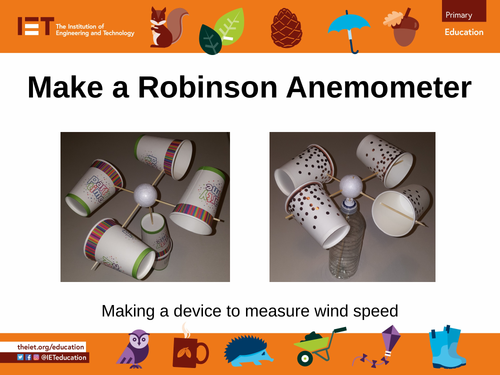


Making a device to measure wind speed
In this science project, students will construct a Robinson Anemometer using common household materials. Once built, students can use it to measure wind speed either inside with domestic items or outside with the natural environment.
This activity can serve as a stand-alone project or as a component of a broader unit on weather or measurement. It is intended for upper Key Stage 2 learners (years 5 and 6).
This resource is part of a collection of free STEM resources created to aid in the teaching of the primary national curriculum, especially in the areas of science and design and technology. The purpose of this activity is to aid in teaching key concepts through the construction of a homemade anemometer.
Parts and components required:
Polystyrene balls, 25 - 40 mm diameter, 1 per anemometer
Wood/bamboo skewers, 3 per anemometer
Putty (such as Blutack or Whitetak) OR modelling clay (such as clay, Plasticine or Playdough).
EITHER 6 paper cups OR 4 paper cups and a plastic water bottle with a sports cap
Sticky tape
Tools and equipment required:
Fans, hair-dryers or other sources of moving air
Stop watches
Commercial anemometer (for extension activity)
The Robinson Anemometer
The Robinson Anemometer is a type of cup anemometer, an instrument used for measuring wind speed. It was invented by John Thomas Romney Robinson in 1846 and is named after him. The Robinson Anemometer consists of four hemispherical cups mounted at the end of horizontal arms, which are attached to a vertical shaft. As the cups rotate due to the force of the wind, the speed of the wind can be calculated based on the rate of rotation. The Robinson Anemometer is still widely used today and is considered one of the most accurate and reliable types of anemometers.
The engineering context
Engineers need to be able to measure the forces that will act on the things they need to design. They need to understand how these measurements are made so that they can be confident that their designs will meet the requirements in practical situations.
Suggested learning outcomes
By the end of this activity students will have an understanding of what is meant by wind, they will be able to construct a simple mechanical device and they will be able to understand that the linear movement of air can be measured by the rotation of an anemometer.
All activity sheets and supporting resources are free to download, and all the documents are fully editable, so you can tailor them to your students’ and your schools’ needs.
The activity sheet includes teacher notes, guidance, useful web links, and links (where appropriate) to the national curriculum in each of the four devolved UK nations; England, Northern Ireland, Scotland and Wales.
Please share your classroom learning highlights with us @IETeducation
Something went wrong, please try again later.
Report this resourceto let us know if it violates our terms and conditions.
Our customer service team will review your report and will be in touch.